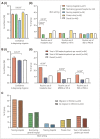Prevalence Rates of Primary Headache Disorders and Evaluation and Treatment Patterns Among Korean Neurologists
- PMID: 36062775
- PMCID: PMC9444561
- DOI: 10.3988/jcn.2022.18.5.571
Prevalence Rates of Primary Headache Disorders and Evaluation and Treatment Patterns Among Korean Neurologists
Abstract
Background and purpose: Several studies have found that the prevalence of migraine is higher among healthcare professionals than in the general population. Furthermore, several investigations have suggested that the personal experiences of neurologists with migraine can influence their perception and treatment of the disease. This study assessed these relationships in Korea.
Methods: A survey was used to investigate the following characteristics among neurologists: 1) the prevalence rates of migraine, primary stabbing headache, and cluster headache, and 2) their perceptions of migraine and the pain severity experienced by patients, diagnosing migraine, evaluation and treatment patterns, and satisfaction and difficulties with treatment.
Results: The survey was completed by 442 actively practicing board-certified Korean neurologists. The self-reported lifetime prevalence rates of migraine, migraine with aura, primary stabbing headache, and cluster headache were 49.8%, 12.7%, 26.7%, and 1.4%, respectively. Few of the neurologists used a headache diary or validated scales with their patients, and approximately half were satisfied with the effectiveness of preventive medications. Significant differences were observed between neurologists who had and had not experienced migraine, regarding certain perceptions of migraine, but no differences were found between these groups in the evaluation and preventive treatment of migraine.
Conclusions: The high self-reported lifetime prevalence rates of migraine and other primary headache disorders among Korean neurologists may indicate that these rates are underreported in the general population, although potential population biases must be considered. From the perspective of neurologists, there is an unmet need for the proper application of headache diaries, validated scales, and effective preventive treatments for patients. While the past experiences of neurologists with migraine might not influence how they evaluate or apply preventive treatments to migraine, they may influence certain perceptions of the disease.
Keywords: Korea; disease management; neurologists; prevalence; primary headache disorders; surveys.
Copyright © 2022 Korean Neurological Association.
Conflict of interest statement
Byung-Kun Kim reports the following in relation to the past 36 months: Grants/contracts with Korea Neurological Association and Y-Brain; Consulting fees from Sanofi Korea and Novartis; Payment/honoraria for lectures, presentations, speakers bureaus, manuscript writing or educational events from GSK Korea, Lilly Korea, Lundbeck Korea, SK Pharm, Ildong Pharm; Support for attending meetings and/or travel from Teva, Eli Lilly and Company, and Novartis; and Participation on a Data Safety Monitoring Board or Advisory Board with National Pension Service. Min Kyung Chu reports the following in relation to the past 36 months: Site investigator for a multi-center trial sponsored by Otsuka Korea, Novartis, International AG, and Eli Lilly and Company; Advisory member for Teva; Lecture honoraria from Allergan Korea, Handok-Teva, and Yuyu Pharmaceutical Company; Grants from the Yonsei University College of Medicine (2018-32-0037) and National Research Foundation of Korea (2019R1F1A1053841). Soo Jin Yu and Sarah Louise Roche are full-time employees of Eli Lilly and Company. Grazia Dell'Agnello and Jeong Hee Han are full-time employees and minor shareholders of Eli Lilly and Company. Hans-Peter Hundemer, now retired from Eli Lilly and Company, was a full-time employee and a minor shareholder of Eli Lilly and Company during preparation of the manuscript. Tommaso Panni is a full-time employee of Eli Lilly and Company for the last 32 months. Previously, Tommaso Panni was a full-time employee at Advanced Medical Services. Sara Prada Alonso is a permanent, full-time employee of Clinipace. Soo-Jin Cho reports the following in relation the past 36 months; Payment/honoraria for lectures, presentations, speakers bureaus, manuscript writing or educational events from Allergan Korea, WhanIn Pharm Co., Ltd., Shinpoong Pharma. Co., Ltd., and SK chemicals; Presidency of Korea Headache Society; Site investigator of a multicenter trial sponsored by Otsuka Korea, Allergan, Ildong Pharmaceutical Co., Ltd., Novartis International AG, Eli Lilly and Company, Hyundaipharm. Co. Ltd., Biohaven Asia Pacific Ltd., H. Lundbeck A/S (Lundbeck), and Parexel Korea Co., Ltd.
Figures

References
-
- Headache Classification Committee of the International Headache Society (IHS) The International Classification of Headache Disorders, 3rd edition. Cephalalgia. 2018;38:1–211. - PubMed
-
- Saylor D, Steiner TJ. The global burden of headache. Semin Neurol. 2018;38:182–190. - PubMed
-
- Woldeamanuel YW, Cowan RP. Migraine affects 1 in 10 people worldwide featuring recent rise: a systematic review and meta-analysis of community-based studies involving 6 million participants. J Neurol Sci. 2017;372:307–315. - PubMed
-
- James SL, Abate D, Abate KH, Abay SM, Abbafati C, Abbasi N, et al. GBD 2017 Disease and Injury Incidence and Prevalence Collaborators. Global, regional, and national incidence, prevalence, and years lived with disability for 354 diseases and injuries for 195 countries and territories, 1990-2017: a systematic analysis for the Global Burden of Disease Study 2017. Lancet. 2018;392:1789–1858. - PMC - PubMed
-
- Vos T, Abajobir AA, Abate KH, Abbafati C, Abbas KM, Abd-Allah F, et al. GBD 2016 Disease and Injury Incidence and Prevalence Collaborators. Global, regional, and national incidence, prevalence, and years lived with disability for 328 diseases and injuries for 195 countries, 1990-2016: a systematic analysis for the Global Burden of Disease Study 2016. Lancet. 2017;390:1211–1259. - PMC - PubMed
Grants and funding
LinkOut - more resources
Full Text Sources
Miscellaneous

